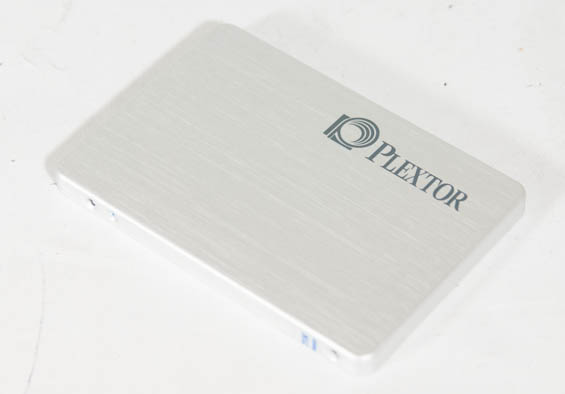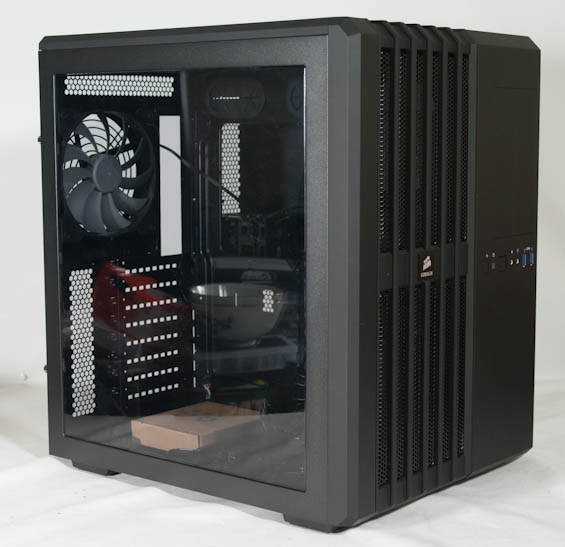The Neophyte's Custom Liquid Cooling Guide: How To, Why To, What To Expect
by Dustin Sklavos on September 30, 2013 12:01 AM ESTPlextor M5P Xtreme 256GB SSD

For this build we needed a fast SSD with enough capacity to hold our entire benchmarking suite, and Plextor was able to accommodate us. The M5P Xtreme we were sent is a 256GB SATA 6Gbps solid state drive with a 7mm height (as is becoming the norm), rated for sequential speeds of up to 540MB/sec reads and 460MB/sec writes, and a random read/write rating of 100,000/86,000 IOPS. It employs an enterprise class Monet 88SS9187 controller, and definitely met our needs during testing.
Our thanks to Plextor for this solid state drive.
Corsair AX1200i Power Supply

Truth be told, Corsair had provided me this power supply some time ago for testing with their Corsair Link software, and it's proven to be absolutely worthy for this build. The AX1200i is a fully modular, 200mm power supply rated for up to 1200 watts and 80 Plus Platinum certified, and it boasts one single, beefy 12V rail. When this unit is running at 30% or less load, the fan actually stops completely, but even under duress I found its fan noise to be negligible at worst. What makes it ideal, of course, is that it can easily supply the required current for two GTX 780s and an i7-4770K with plenty of overclocking headroom. The Corsair Link support is an added perk.
Our thanks to Corsair for this power supply.
Corsair Carbide Air 540 Enclosure

When it came to choosing a case, I really had my pick of the litter. You can plead favoritism, but honestly I've found Corsair's mid-to-high end offerings to be the most desirable for watercooling. Initially I'd planned on using the Micro-ATX Obsidian 350D, but then the Carbide Air 540 launched and I elected to go full ATX. In addition to just being a very interesting looking case, the Carbide Air 540 is perfect because it lets me test an air cooled system for comparison without having to use a case with middling air cooling performance. The case also supports a 360mm radiator in the front and a 240mm radiator in the top, giving a very healthy amount of cooling capacity when the switch to watercooling is made.
That, and like I said, it's just really neat.
Our thanks to Corsair for this enclosure.
Noctua NH-U14S Air Cooler

In order to prove the hypothesis we're entering into this review with, we need a control. Noctua's NH-U14S air cooler serves as that control; this cooler is incredibly quiet but also very efficient. This and its smaller sibling, the NH-U12S, are two of my favorite air coolers. Though they don't come cheap, they're awfully close to as good as you'll get on air if noise matters to you. The NH-U14S did not disappoint.
Our thanks to Noctua for this cooler.


_thumb.jpg)
_thumb.jpg)
_thumb.jpg)
_thumb.jpg)
_thumb.jpg)
_thumb.jpg)








106 Comments
View All Comments
madisoncarter127 - Monday, September 30, 2013 - link
himadisoncarter127 - Monday, September 30, 2013 - link
My last pay check was $11000working 10 hours a week online. My brothers friend has been averaging 17k for months now and she works about 18 hours a week. I can't believe how easy it was once I tried it out.dgingeri - Monday, September 30, 2013 - link
You've sold me on the case, and convinced me to not try water cooling for a while longer, and possibly never. It looks like a lot of hard work for little to no reward. I'll stick to my H100. The case looks great, though.Shinobi_III - Monday, September 30, 2013 - link
If you put the pump in a reservoir, you will no longer have a "noisy" pump.Noisy being a rather absurd wording, considering how incredibly little noise a EHEIM 600l/h pump produces.
That pump you used in the article is ridiculous, what is that, a pump for ants?
And compression fittings are complete suicide, they fail sooner or later.
Perfectly regular ridged slide-over fittings, and a zip tie if you're nervous, will never fail.
And the coolant is ridiculous too, get "long life" automotive coolant, mix it 1:10 and you will never need to worry again. Those bottles are just rebranded, ready-mixed glycol with a giant price tag.
HisDivineOrder - Monday, September 30, 2013 - link
Watercooling GPU's makes sense, but how long before CLC is common on those? It can't be long since everyone's used to CLC's on CPU's where you don't even need water cooling at all. I imagine it won't be long before GPU's too don't need watercooling anymore since they'll be integrated into the CPU.Given that Intel will make its own version of Mantle in short order that they'll pay entire publishers to use, I'm pretty sure we can kiss any advantage discrete cards have goodbye. I'm sure Intel will send AMD a fruit basket for both the idea and making everyone okay with it.
ImSpartacus - Monday, September 30, 2013 - link
Hot damn, this is comprehensive as fuck.Good article!
livingplasma - Monday, September 30, 2013 - link
Thanks for the great article, it's good to see a major tech site like Anandtech cover the often misunderstood art of water cooling. Just skimmed through the comments and a lot of my fellow water cooling guys/gals made some very important points. From my experience it is most important for radiator fan orientation to act as INTAKES. Flipping those top fans to intake can decrease your load temps ~8 degrees celcius from my experience as the way it's currently set up the top 2x120 radiator is using the air from the 3x120 radiator (which is already saturated with heat). Properly decoupled pumps will minimize noise/vibration transmission to the case and with the MCP35X's PMW control it can run very quietly when slowed down 50% which is more than enough flow for most setups. Radiators themselves are low flow resistance, full cover gpu blocks are probably next and CPU blocks tend to have the most but even maxing out a pump only decreases temperatures CPU by a degree or two (plus now the pump is dumping in more heat as well). Removing the stock GPU cooling setups is probably the biggest contributions to water cooling being more quiet than a regular air setup and even with a modest setup the temperature differences are huge as shown with the author's setup.1Angelreloaded - Monday, September 30, 2013 - link
Dustin, Do you know the difference between a Serial and Parallel loop? or how the High flow and Low Flow pressures effect heat dissipation on certain blocks? I understand this may be your first time setting this up; however, in the computer field research is everything, you already know this just like modifying a car without research you end up with an underperforming and underwhelming creation. This is not how a liquid cooled setup should be set up at all, and BTW your Proc temps are higher because the Air source feeding it is already heated from your GPU Rad outlet, try reversing the flow on intake to exit Flow and your CPU temps will be better, CPUs on average run at lower temps on full loads compared to GPUs that can average 70-80 C especially while gaming.hot120 - Tuesday, October 1, 2013 - link
Man, there are quite a few fake 'experts' critiquing this fine article. It seems everyone wants the article done their way. Delid this CPU, change that fan, move this radiator, use that Kill Coil. Enough is enough. It is a basic article on watercolling, and is not meant to cover EVERY SINGLE POSSIBLE configuration. Only the most extreme of the extreme computer users will consider delidding their CPU's. Only the most insane of the extreme computer users will spend $800 on a custom loop to shave 5-10 degrees off their CPU/GPU temps. I'll take my $100 and by a CLC and live happily ever after with my CPU that is +10 degrees (over custom) and my air-cooled GPU. Some of you are tripping!pandemonium - Tuesday, October 1, 2013 - link
Thanks for the introduction article to watercooling. To me - verified according to the results - this says it's still not worth it for a general user and gamer. The cost of increased power, thermals, and noise do not appear to outweigh the performance increase. I know other setups produce better results, but this is a good sample for not bothering with it.Watercooling is still for benchmarking...and that's about it.